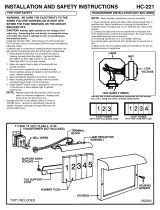
Thisish1
-- 2 --
clka1--e1
LIST OF CONTENTS Page
INTRODUCTION 2............................................................
RATING PLATE 4.............................................................
COMPONENT DESCRIPTION, LKA 180/240 6...................................
CONNECTION DIAGRAM, LKA 180 Single -- phase, 230 V 7.......................
CONNECTION DIAGRAM, LKA 180 3-- phase, 400 V 8...........................
CONNECTION DIAGRAM, LKA 180 3-- phase, 230/400 V 9.......................
CONNECTION DIAGRAM, LKA 240 3-- phase, 400 V 10...........................
CONNECTION DIAGRAM, LKA 240 3-- phase, 230/400 V 11.......................
CIRCUIT DIAGRAM, CIRCUIT BOARD AP1 12....................................
COMPONENT POSITIONS, CIRCUIT BOARD AP1 14.............................
DESCRIPTION OF OPERATION, CIRCUIT BOARD AP1 15........................
LOAD CHARACTERISTICS 19..................................................
TECHNICAL DATA 20..........................................................
INSTALLATION 21.............................................................
OPERATION 22...............................................................
MAINTENANCE 23............................................................
WELDING DATA SELECTION 23................................................
REPLACING THE WIRE GUIDE 26..............................................
REMOVING / REFITTING THE GAS NOZZLE 26..................................
REMOVING / REFITTING THE GAS DIFFUSER 26................................
SPARE PARTS LIST, LKA 180/240 27...........................................
INTRODUCTION
This service manual is intended for use by technicians with electrical training when carrying
out fault tracing and repair of the equipment.
At the end of the manual, there is a brief guide to using the machine i n order to assist in
understanding the machine.
The manual contains all design modifications introduced up to and including June 1996.
Use the diagrams in the manual when tracing faults. The machine components are described
in alphabetical order on the pages following the connection diagram.
The LKA 180 and 240 are designed and tested in accordance with international
standard EN 60 974--1 (IEC 974--1).
On completion of service or repair work, i t is the responsibility of the person(s) etc.
performing the work to ensure that the product does not depar t from the requirements
of the above standard.
Rights reserved to alter specifications without notice.




















